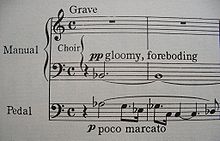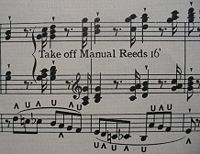|
Sonata on the 94th Psalm The Sonata on the 94th Psalm in C minor is a sonata for solo organ by Julius Reubke, based on the text of Psalm 94. It is considered one of the pinnacles of the Romantic repertoire. It is in three movements:
An average performance lasts 23 – 28 minutes. Composition Reubke composed the sonata while he was studying piano and composition in Weimar with Franz Liszt, and living at the Altenburg house. He composed it at the same time as his other large work, the Piano Sonata in B-flat minor, and finished it in April 1857. He dedicated it to Professor Carl Riedel and played the premiere on the Ladegast organ (1853-1855) of Merseburg Cathedral on June 17, 1857. The 94th Psalm Sonata is considered to be inspired by Liszt's Fantasy and Fugue on the chorale Ad nos, ad salutarem undam, Piano Sonata, symphonic poems and Wagner's operas. It is nonetheless a very individual work composed well for the organ, requiring advanced pedal technique and a resourceful use of all the organ's departments. ProgrammeThe 94th Psalm sonata is a symphonic poem, and the three movements are connected but formally independent. It is programme music in that the text of the psalm is used to inspire the mood of the piece. These verses accompanied the first performance: The 94th Psalm
(Grave - Larghetto) (Allegro con fuoco) (Adagio) (Allegro) Form The first and second movements are in sonata form; the third movement is a fugue which also has elements of sonata form. An impression of spontaneous improvisation is achieved by the overlapping and enmeshing of phrases and movements, which allows the avoidance of regular structures. All thematic phrases are also shaped irregularly, producing such great diversity that no musical idea is repeated exactly. The opening theme of the piece provides the basis of all the rest of the thematic material. This music is an interpretation of the text 'Herr, Gott, des die Rache ist, erscheine'; a head-motif is followed by a descending chromatic scale. Ascending chords on the manual follow, a musical invocation of God. The development section of the first movement, from the allegro con fuoco, depicts the second group of verses, leading into a recapitulation in organo pleno. The adagio second movement depicts the Bekümmernisse (sorrows) and Tröstungen (consolations) moods of the third group of verses, and closes with a reappearance of the opening theme of the sonata.  
Performance and recordingsThe 94th Psalm sonata is in the repertoire of most concert organists, and has been recorded by many well-known players such as E. Power Biggs, Catherine Crozier, Michael Schönheit, Simon Preston, Alan Morrison, Virgil Fox, Christopher Herrick, Gillian Weir, Jeremy Filsell, Daniel Roth, Kevin Bowyer, David Briggs and Jean Guillou. There is also a variation of the piece compiled and performed by Timothy Howard as part of his organ soundtrack score for the 1922 film, "Nosferatu."
Sources
External links |